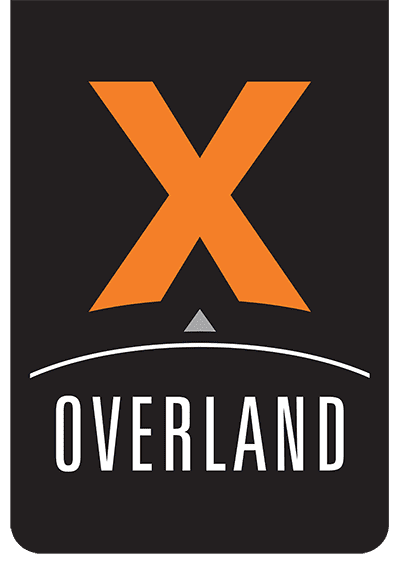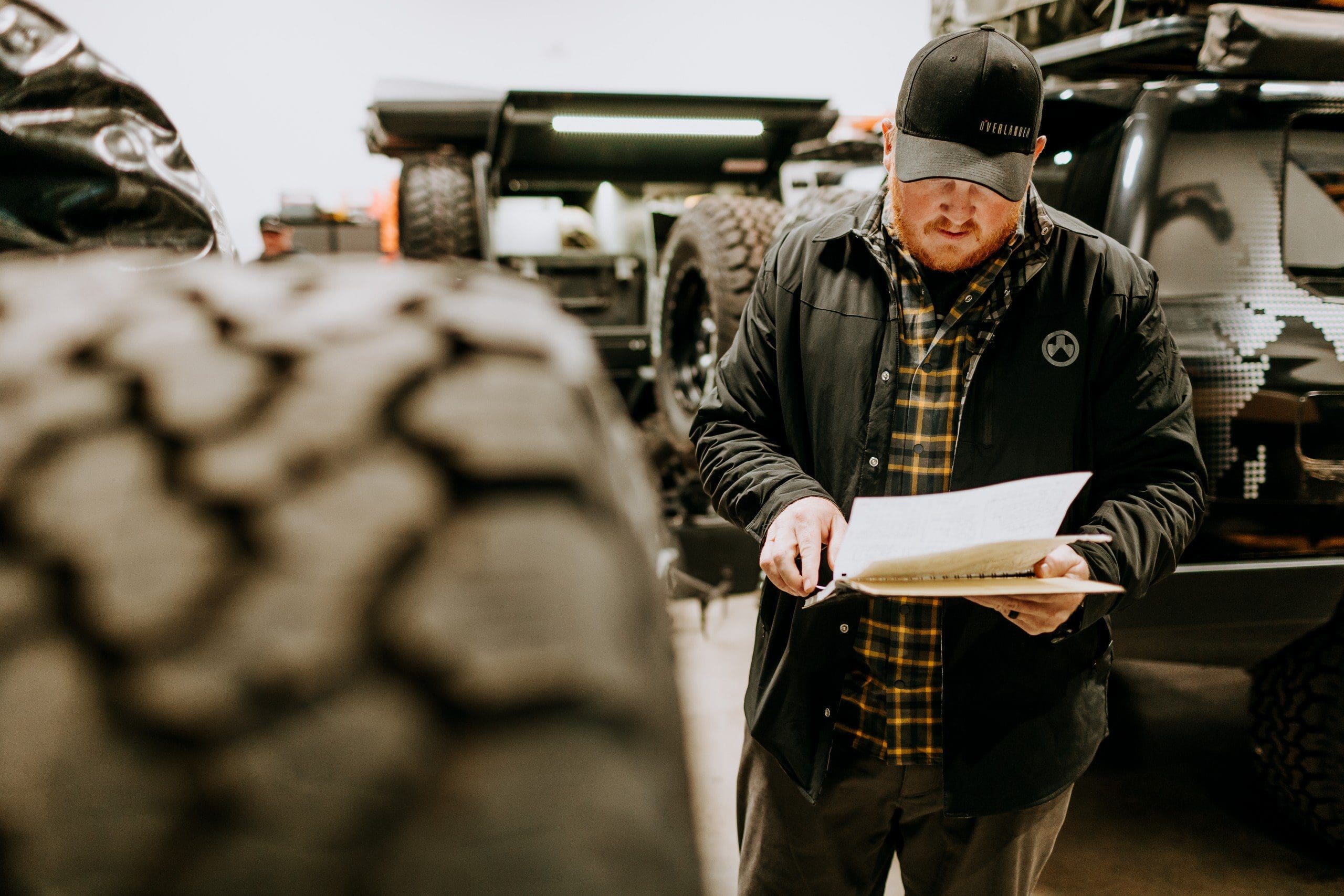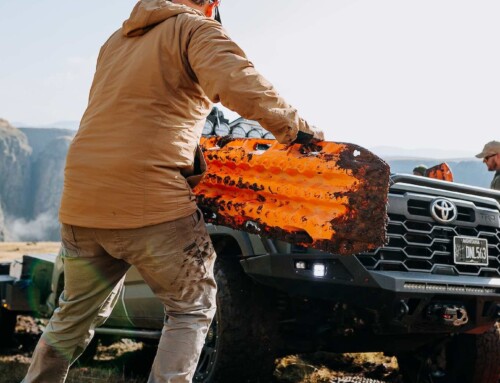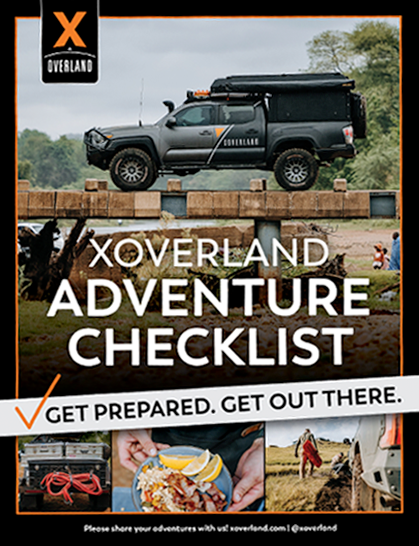This week we’re sharing our tips and tricks on vehicle maintenance. Although each Expedition Overland vehicle is unique, there are certain universal checks and balances we use regularly to ensure the safe and optimal performance of our fleet. These tips might seem basic at first, but if you’re getting into overlanding this information is important to know.
As an overlander it is important to accurately talk and communicate about your vehicle. One of the best ways to do this is by investigating and using the five senses to examine your vehicle regularly. This can be achieved by compiling vehicle information, observing vehicle angles and conducting regular inspections. We’ll dive into the details below.
Compile Vehicle Information
First, pull out that Owner’s Manual! It is an invaluable resource. Next, create a document or spreadsheet detailing the information below. Most of these items are listed in your Owner’s Manual. Not only will this list help you familiarize yourself with your vehicle, but it is also a great reference point when ordering parts, discussing your vehicle or speaking with a mechanic.
- Oil type and quantity
- Oil filter and part number
- Air filter and part number
- Gross Vehicle Weight Rating (GVWR): this is your vehicle’s curb weight plus payload (also found inside the driver door)
- Stock wheel size, tire size and recommended tire pressure
Know your vehicle’s ground clearance. Measure from the lowest point of the vehicle body to the ground to determine this. If your vehicle has been modified, make note of the type of suspension: Independent Front Suspension (IFS)? Leaf springs? Solid front axle? Coilovers? Do you know where to fill radiator fluids, transmission fluids and how to check the oil? If not, your trusty Owner’s Manual should spell out the details. Experiencing your vehicle’s reaction time is also very important. This not only tells you whether or not your brakes are working properly, but how quickly your brakes respond in an emergency situation. This is about learning how your vehicle responds NOW, as opposed to when an elk jumps across the road in front of you. To do this, take your vehicle out for a spin. Before departing, empty out your vehicle completely – no water bottles, tools, lunch bags, etc. Drive to a safe location without any traffic. Do this exercise at your own risk. Accelerate up to 60 mph, then hit your stopwatch or start counting in your head as you hit the brakes hard – to full lock up (as you would if something ran out onto the road and you had to stop suddenly). Make note of how long the vehicle took to respond. Are your brakes working properly? Is the ABS functioning? Try on both dry and wet pavement. This exercise primes your response time in an emergency situation and gives you an idea of how your vehicle reacts. Of course, again, do only at your own risk in a safe location void of traffic.
Observe Your Vehicle Angles: Approach, Break-Over and Departure
Vehicle angles reveal a vehicle’s capability at overcoming obstacles in an off-road environment. There are three types of vehicle angles: approach, brake-over and departure. 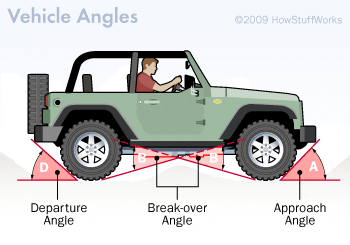 Approach angle: at the front of the vehicle, the angle between the front tires and the lowest part of the body of the vehicle. This angle represents the steepest incline your vehicle can climb without scraping the front bumper. Break-over angle: The angle from the lowest part of your vehicle to where it meets bottom of both the front and rear tires. The break-over angle illustrates the steepest hill a vehicle can drive over without contacting the undercarriage. Departure angle: The angle from the bottom of your rear tire to the lowest part of the body of the vehicle to the rear. This angle represents the steepest decline your vehicle can descend over without scraping the rear bumper. Observing these angles is a great way to avoid vehicle damage while tackling off-road obstacles.
Approach angle: at the front of the vehicle, the angle between the front tires and the lowest part of the body of the vehicle. This angle represents the steepest incline your vehicle can climb without scraping the front bumper. Break-over angle: The angle from the lowest part of your vehicle to where it meets bottom of both the front and rear tires. The break-over angle illustrates the steepest hill a vehicle can drive over without contacting the undercarriage. Departure angle: The angle from the bottom of your rear tire to the lowest part of the body of the vehicle to the rear. This angle represents the steepest decline your vehicle can descend over without scraping the rear bumper. Observing these angles is a great way to avoid vehicle damage while tackling off-road obstacles.
Inspect Your Vehicle Regularly
At Expedition Overland we treat our vehicles like any good pilot would treat his or her airplane by carrying out pre-’flight’ checks regularly. We’ve caught plenty of minor issues, with the potential of becoming major ones, just by being proactive. If you’re willing to be consistent, regular daily, weekly and monthly vehicle checks will become instinctual in no time. Daily Walk-Up Inspection Conduct a walk-up inspection every time you approach the driver’s seat. Here are some specific areas to observe while giving your vehicle the once-over.
- Approach from the side, observing beneath the vehicle. Do you notice any drips? If yes, chase down the cause and fix.
- Look at the paint and the wheels. Look for oil splotches on the surface of the paint. As oil droplets hit the wind they are broken up into particles, eventually hitting your back tailgate. These splotches are a tell tale sign of ‘dripping while driving.’
- Observe your CV boots. This flexible rubber boot is a common place for failure at any given time, especially on a lifted vehicle.
During the first drive of every day, turn the tunes off and spend the first mile listening to the sounds of your vehicle. Do things feel and sound right in reverse? In drive? Do you hear any new sounds? Any rattling? If so, make note of the differences. As Clay’s Grandfather once said, “Your car talks to you, you just better be listening.” For more on this subject watch: “Oh Hey There!” Vehicle Maintenance Walk-Around with Jeff.
Weekly Inspection These items are best checked on a weekly basis.
- Pop the hood! We take a hands-on approach by wiggling, touching and observing a cool engine. These preventative measures will address failure points before they fail.
- Clean your air filter by blowing on it or gently knocking it on the ground. Ensure you’ve replaced it securely.
- Check fluid levels. Are your windshield washer fluids, radiator fluids and transmission fluids topped up? Note that fluid levels in an automatic transmission need to be checked when the engine is running.
- Inspect hoses and clamps. Check for stiffness, cracks, areas of fatigue and missing clamps. Are the hoses routed in their proper clips?
- Look over main battery connections. Confirm that the battery terminals are tight and free of corrosion. Over time, vibrations can result in internal battery failure.
- Watch for uneven tire wear in order to catch a bad alignment sooner rather than later. This occurs more frequently on the front tires. Check this once per month if you have a dedicated off-road vehicle that isn’t your daily driver.
- Check those lug nuts! Before it fails, a nut will loosen. These are worth checking on a daily basis if you are on a long-term overland trip, saving you from a catastrophic accident.
Monthly Inspection These items are best checked on a monthly basis.
- Grab the 9 o’clock and 3 o’clock positions of each tire and shake back and forth. Feeling unusual movement or clunking sounds can be a sign of bad tie rod ends, steering components or loose connections.
- Grab the top of each tire and shake back and forth. A knocking sound might indicate a bad ball joint or a worn wheel bearing.
- Physically crawl underneath your vehicle and take a peek. Shake stuff. Are the brackets okay? Are there any cracked or split rubber components? Any missing bolts? Does anything look bent? Is there any mud trapped where it shouldn’t be? Is there any grass trapped that could potentially cause a fire? If you have a skid plate, is it clean on top?
- Check the wiring. Are there any wires that are overheated, dried or cracked?
It is also important to do a thorough run-through of all systems once per month. This includes all lights, pumps and heater systems, any factory or air lockers (for a mile or two per month), and your winch. Activate 4WD and 4lo. Testing these systems not only keeps things lubricated and working optimally, it is also much safer to address problems ahead of time.
We’ve put together a Vehicle Maintenance Checklist summarizing the daily, weekly and monthly vehicle checks in an easy-to-use format!
We hope you have found these tips helpful. What kind of pre-checks and vehicle maintenance do you use? Do you have a regularly scheduled inspection? Let us know in the comments below!
